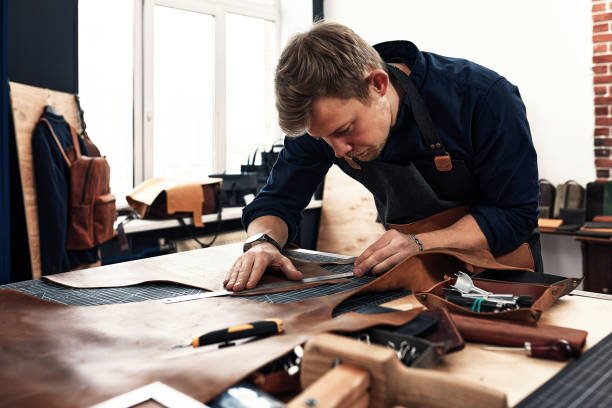Leather crafting is an age-old art that blends creativity, skill, and patience. Around the world, it has been practiced for centuries to create durable and functional items. Today, it is not only about making everyday goods but also about exploring design, technique, and tradition. In Singapore, the concept of a leather crafting workshop is gaining popularity as people look for hands-on learning experiences, sustainable crafting methods, and meaningful hobbies.
Understanding Leather Crafting
What is Leather Crafting?
Leather crafting is the process of designing, cutting, shaping, and stitching leather into useful products. From wallets and belts to bags and accessories, the craft allows individuals to transform raw materials into long-lasting goods. It involves a range of techniques, including carving, dyeing, stamping, and finishing.
The Role of Leather in History
Leather has played a vital role in human history. Ancient civilizations relied on it for clothing, armor, footwear, and storage. Over time, artisans refined methods to create softer, more versatile types of leather. Today, workshops keep these traditions alive while introducing modern approaches and eco-friendly practices.
Why Learn Leather Crafting?
Learning leather crafting offers more than just a new skill. It provides a sense of achievement, encourages creativity, and allows people to make personalized items. It is also sustainable because handmade leather goods last longer and reduce reliance on mass production.
Leather Crafting Workshops in Singapore
The Growing Interest
In Singapore, leather crafting workshops are becoming popular for individuals, families, and groups. People attend them to learn basic skills, bond with others, or enjoy creative time away from digital devices. Some workshops cater to beginners, while others provide advanced lessons for those who want to master complex techniques.
What Participants Can Expect
Workshops usually begin with an introduction to different types of leather, tools, and safety practices. Beginners learn basic stitching and cutting methods. Depending on the program, participants may create simple items such as keychains, cardholders, or wristbands. More advanced sessions focus on larger projects like bags or custom designs.
Accessibility in Singapore
Leather crafting workshops are available across Singapore, from community spaces to creative studios. Many sessions are open to all age groups, making them a family-friendly activity. Students, professionals, and hobbyists often take part to relax, develop new skills, or explore sustainable crafts.
Tools and Materials Used in Workshops
Basic Tools for Beginners
Beginners are introduced to essential tools like cutting knives, stitching needles, mallets, and pricking irons. These instruments help shape, punch, and stitch leather with accuracy.
Types of Leather Commonly Used
Workshops typically use vegetable-tanned leather, which is sturdy and eco-friendly. Chrome-tanned leather may also be introduced for its flexibility and smooth surface. Each type has unique characteristics, giving participants opportunities to explore various textures and finishes.
Safety and Maintenance of Tools
Safety is emphasized in workshops because many tools are sharp. Instructors guide participants on proper handling and storage. Learning how to maintain tools is also part of the process, ensuring durability and consistent performance.
Techniques Taught in Leather Crafting Workshops
Cutting and Shaping
Participants learn to cut leather accurately using knives and templates. Proper shaping ensures items are symmetrical and functional.
Stitching Methods
Workshops often teach saddle stitching, which creates durable seams. Other methods include cross-stitching and decorative stitching, adding both strength and style to the final product.
Dyeing and Finishing
Dyeing gives leather a unique color, while finishing protects it from wear. Participants experiment with different finishes, from matte to glossy, to achieve the desired effect.
Benefits of Attending a Leather Crafting Workshop
Skill Development
Workshops enhance fine motor skills, patience, and attention to detail. Participants also gain problem-solving abilities as they learn to work through mistakes.
Stress Relief
Engaging in hands-on activities helps reduce stress and improve mental well-being. Focusing on crafting allows individuals to disconnect from daily pressures.
Social Interaction
Workshops in Singapore often bring together diverse groups of people. Working side by side fosters communication, teamwork, and cultural exchange.
Creating Personalized Items
Participants leave with handmade products that reflect their creativity. These items often carry sentimental value because they are unique and self-made.
Leather Crafting as a Sustainable Practice
The Eco-Friendly Aspect
Leather crafting promotes sustainability by encouraging handmade, long-lasting products. This reduces waste and minimizes the impact of fast fashion.
Upcycling Old Materials
Some workshops in Singapore focus on upcycling, teaching participants how to repurpose old leather goods into new items. This practice supports environmental awareness and resourcefulness.
Ethical Sourcing
Workshops also emphasize ethical sourcing of leather. Many use vegetable-tanned options that are biodegradable and processed without harmful chemicals.
Who Can Join a Leather Crafting Workshop in Singapore?
Beginners and Hobbyists
Workshops are ideal for people with no prior experience. The structured lessons allow anyone to learn step by step.
Students and Professionals
Students benefit from learning a new skill, while professionals see it as a creative escape from routine work.
Families and Friends
Workshops are popular for families and groups of friends who want to spend quality time together while creating something meaningful.
Corporate Groups
Leather crafting workshops are also used for team-building activities. Companies in Singapore often organize these sessions to encourage collaboration and creativity among employees.
Tips for Making the Most of a Workshop
Be Open to Learning
Leather crafting takes patience and practice. Participants should embrace mistakes as part of the learning journey.
Ask Questions
Instructors provide valuable insights. Asking questions helps participants understand techniques better and apply them effectively.
Practice at Home
After attending a workshop, continuing to practice at home enhances skills. Simple projects like keychains or bookmarks are good starting points.
Take Care of Finished Products
Proper care extends the life of handmade items. Conditioning and cleaning leather regularly keep it looking fresh and durable.
The Future of Leather Crafting in Singapore
Rising Popularity
As more people look for mindful hobbies, leather crafting is expected to grow in popularity. Workshops will continue to evolve to meet this demand.
Integration with Modern Design
Leather crafting in Singapore is merging with modern design trends. Participants can now experiment with minimalist styles, functional products, and eco-conscious methods.
Educational Opportunities
Schools and community centers may integrate leather crafting into their programs, giving younger generations exposure to this timeless craft.
Global Influence
Singapore’s workshops are influenced by global leather crafting trends, combining traditional practices with innovative approaches. This makes the craft both local and international in appeal.
Conclusion
A leather crafting workshop in Singapore offers a unique way to learn an ancient craft, develop practical skills, and explore creativity. It connects people to tradition while promoting sustainability and personal expression. Whether someone joins to create a small accessory, bond with others, or explore a meaningful hobby, the experience is rewarding and memorable. Leather crafting continues to grow as a valuable activity in Singapore, reflecting a balance of artistry, sustainability, and modern lifestyle.



